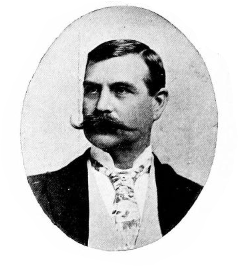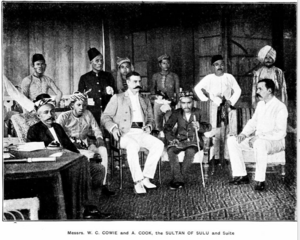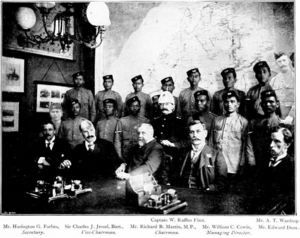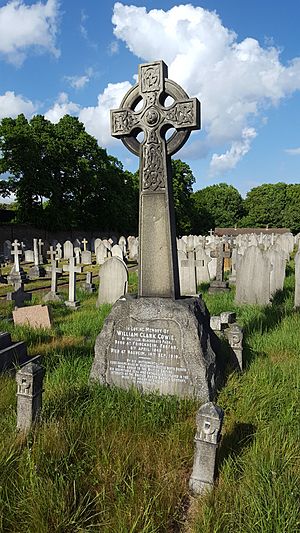William Cowie (merchant) facts for kids
William Clark Cowie (born April 8, 1849 – died September 14, 1910) was a Scottish engineer, sailor, and businessman. He played a big part in creating British North Borneo and later became the leader (Chairman) of the British North Borneo Company.
Contents
Early Life and Training
William Clark Cowie was born in Friockheim, Scotland, on April 8, 1849. He was the oldest of four children. His father, David Cowie, worked with flax, a plant used to make fabric.
His family later moved to Arbroath on the east coast of Scotland. William trained to be an engineer, just like his grandfather. He even had private lessons to help him learn.
William married Flora Davidson around 1873. They had two children, Flora and William. Sadly, his wife Flora died young. Later, William married Amy Constance Pead, and they had two more children, Muara and Andson.
Adventures at Sea
In April 1870, when he turned 21, Cowie became the chief engineer on a ship called Argyle. He sailed from Glasgow to Singapore. This began his adventurous life in the Malay Archipelago, a group of islands where pirates were common.
By the end of 1872, Cowie became a captain. He was hired to help the Sultan of Sulu, who ruled parts of northern Borneo. The Spanish navy was blocking the Sultan's trade routes, stopping his ships. Cowie successfully broke through this blockade, bringing goods to the Sultan. This made them good friends.
Cowie convinced the Sultan that he needed a safe port to hide from the Spanish ships. The Sultan allowed Cowie to build a port on Timbang Island in Sandakan. This was an important step for Britain to have a presence in Borneo. Cowie and his friends, Carl Schomburgk and John Dill Ross, started the Labuan Trading Company. Their main job was to get weapons, tobacco, and other goods to Sulu, avoiding the Spanish navy. They were very good at it, and the Spanish never caught their ships!
Building British North Borneo
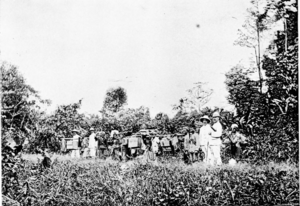
In 1878, two important people, Baron von Overbeck and Alfred Dent, asked Cowie for help. They knew he was friends with the Sultan of Sulu and wanted to get land agreements in Borneo. Cowie agreed because he wanted to help the British Empire gain territory.
Cowie helped the Sultan agree to give up his lands in north-eastern Borneo on January 22, 1878, for a yearly payment. These rights were then given to Overbeck and Dent. Later, in 1881, these rights were passed to the new British North Borneo Company.
In 1882, Cowie bought the rights to mine coal in Muara, Brunei, for 40 years. He started his own company, Cowie Brothers. He even rented a shipyard for 99 years to ship his coal. In 1887, Cowie gave his mining rights to the British North Borneo Company and moved back to England with his family. The coal mine was later renamed "Brooketon".
In 1887, Cowie was asked to manage the company's business in Borneo. He saw that there was no easy way to move goods around the island. So, he wanted to build a railway line from the west coast to Sandakan. The company agreed and made Cowie a supervisor in 1894. Construction of the North Borneo Railway began in 1896. However, they faced money problems and couldn't finish the railway to all of northern Borneo.
Cowie was known for knowing a lot about Borneo and its people. He became a top leader (Director General) in 1897. In 1898, he met with a local leader named Mat Salleh to try and end the conflict known as the Mat Salleh Rebellion. On October 15, 1909, Cowie became the Chairman of the British North Borneo Company.
Later Life and Legacy
Towards the end of his life, Cowie had heart problems. In July 1910, he traveled to Germany for surgery. Sadly, his health got worse, and he passed away on September 14, 1910.
His body was brought back to England and buried on September 23 in Charlton cemetery. His gravestone tells us about his achievements:
|
Thanks to him, 31,000 square miles of land in British North Borneo were added to the British Empire. His amazing effort and excitement helped the British North Borneo Company become successful. |


